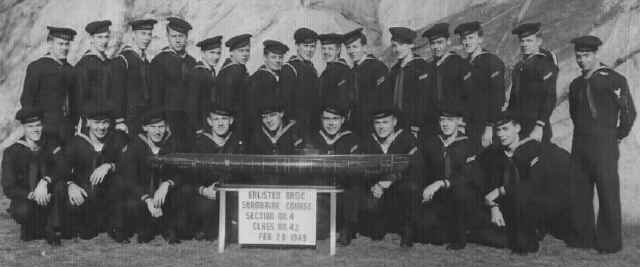
To return to memories of the SS 320,
click here.
To return to the main page of the SS 320, click here.
Memories of
George Gambel '48 - '52
I spent my time on the Bergall as a forward room torpedoman.
While looking for an easy watch to stand in sub school, I took the test for a Navy Drivers Lic. (Which turned out to be an all day test). I didn't get any driver assignments in New London but years later after I had reported aboard and we finally got an overhaul in Philadelphia I was assigned duty driver. The CO lived across the river in New Jersey and had to be picked up at the ferry every morning. So, when it came my turn to drive, I went out, swept the snow out of the open jeep and drove to the ferry landing. Everything went well until the CO said "Can't you step it up a bit?". I said, truthfully, "Okay, Cap'n, but you should be advised that I am from California and have never driven in snow before.". He was then happy with my slow driving and I no longer had duty driver assignments.
Gene Maxim was in my sub school
class also on the Bergall. After discharge we drove cross country in his
gray 1939 Plymouth sedan. Great ride 'til we broke down in Denver.
The rest of it was not bad at all. Denver girls were bright, blonde and smiling
and the beer was pale, sharp and tasty. The altitude and attitude
was great. Here's our sub class. I'm fourth from the
right in the front row and Gene is second from the right.

I reported aboard the Bergall
from Submarine School on March 19, 1949 as a SA ( Seaman Apprentice) and was
promoted to SN as soon as I learned to stand lookout, helm and bow and stern
plane watches and, of course, in port topside watches. At that time
nobody was advanced in rate further than Seaman or the rate they came aboard in
until they were qualified in submarines. Some people came aboard
already rated as a petty officer but could not advance until qualified.
I was destined to be a torpedoman because I had avoided barracks detail while
waiting for security clearance for sub school by taking submarine ordnance
school. I was shipped off TDY to Mine Warfare School in September of
that year because the powers that be determined that we would also be a mine
laying boat and they needed someone who knew mines so my qualification was
somewhat delayed.
I qualified in 1950 and was promoted to TM3SS shortly after that. I took the
test for TM2SS and was promoted as soon as I had the necessary one year in rate.
I was promoted to TM2SS in October of 1951. I took the test for
TM1SS , passed and was notified that I would be promoted in October of 1952
(Necessary one year in rate) but instead took my discharge in June 1952.
I made a mistake in that discharge.
During one operation, I had to crawl in #4 tube in the middle of a mine plant
and loosen a jammed stop bolt. I didn't like that at all but I had a
good reload crew who chose not to trap me in the tube with a mine. We were
shooting a tube every minute or so.
When I climbed aboard when the
BERGALL still had her guns from WWII. These were soon removed but
not before I had a chance to fire them. Cotton was stuffed in the
ears of anyone topside who didn't want to lose their hearing. I can
recall another torpedoman and I looking at the girls on a tour boat in Pearl
Harbor through the 7X50 sights from the 5" gun and then getting chewed out for
threatening the tour boat by pointing a deck gun at them. Here is a picture
taken off Lanai Roads. They say practice makes perfect.
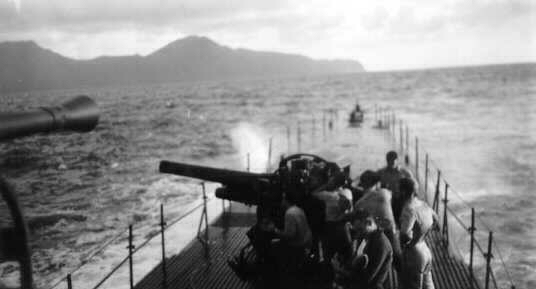
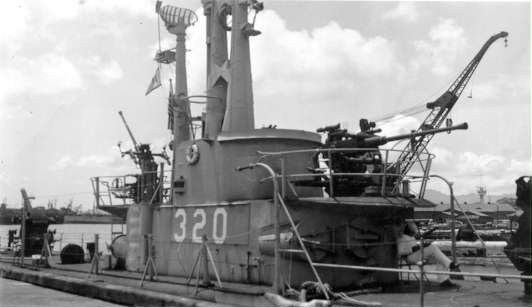
Here's her cigarette deck with her 40 mm guns in 1949.
During upkeep in 1949, I "accidentally" dropped a chipping hammer over the side. COB Frank Vodopich said don't worry, I'll get you another one. When he came back with a new one, he said, "Now you SOB, if this one falls over the side too, you still better still be hanging on to it".
There was a Mae Ling at the Brown Derby in Honolulu that was really beautiful and a singer. One of my shipmates got her in a dark corner and did some really serious soul kissing. Finally got his hand up her dress and found the wrong equipment. Charges were also dropped due to management's desire to avoid publicity. I was jealous of him at first, at least until the hand went up her/his dress... She/he was also a good singer.
A recent (29 Jun 2000) newspaper
announced that the S.S. Lurline is to be sold for scrap. She was a
cruise ship with a regular run from the West coast to Honolulu. She
was used by the family of many military guys transferred to from Hawaii.
The Bergall and other boats used to lay in wait for her and make a approach
which terminated in 6 water slugs fired at her. I wonder how many
time the Lurline was theoretically sunk by our boats? If they
saw the scope we failed. Our approach was conducted as if war
existed.
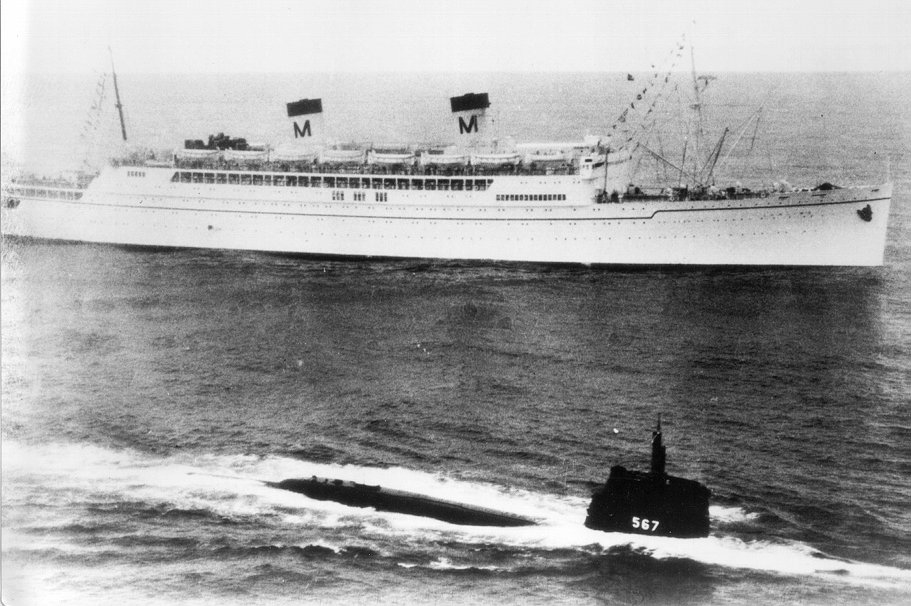
When we left Pearl Harbor, a messenger on a Cushman Scooter delivered some last minute instructions to the yeoman. When he came back topside his scooter was missing. Since a whole scooter will not go down the hatch of a submarine we were not suspect. A little thought would have told them that it could be dismantled in minutes by four enginemen and the parts WILL go down a hatch. It was of course repainted before we got to New London.
After leaving Pearl for Panama,
on June 12, 1950, the Bergall celebrated her 6th birthday and our baker served
up a tribute.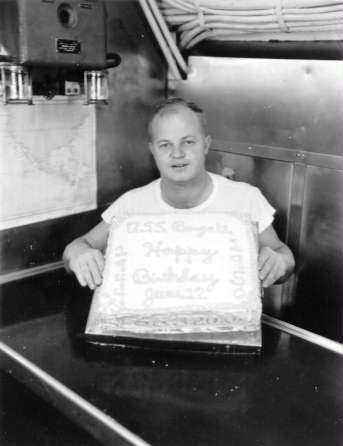
On 6-27-1950, we arrived at the Panama Canal two days earlier than expected! The Canal Defense Forces scrambled all available defense forces until we could get through loud and clear with the IFF. Somebody determined that, since the Korean War started on the 25th that some unknown submarine had thoughts of damaging the canal. The Bergall was not expected that early! We took one Phd from UC Berkley with us and dove every 50 miles for the purpose of development of inertial navigation. I recall that he was my favorite kind of person --- a lousy poker player and a good loser. We dove every 50 miles and I think he took magnetic measurements but he was in a little compartment that had been converted from our 5" magazine and there wasn't room for two people in there. Bothersome part was when the dive took place during mealtime and we had to get up and fold two tables so he could get into his little hole. The pinging got on peoples nerves due to the constant high pitched PING..........PING.......We used passive because active was like trying to sneak up on someone in the dark with a strobe light on your head.
We went through the locks of the
'ditch' (Panama Canal) and had some great liberty times on our way through.
The first shot is passing through Guantano Lock followed by San Pedro Miguel
Lock, Panama Canal early in July.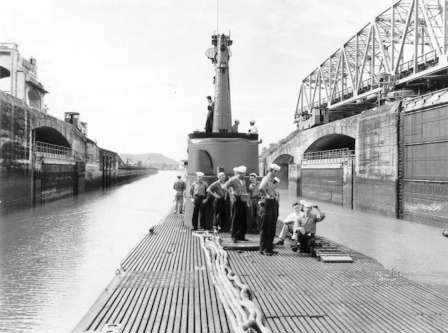
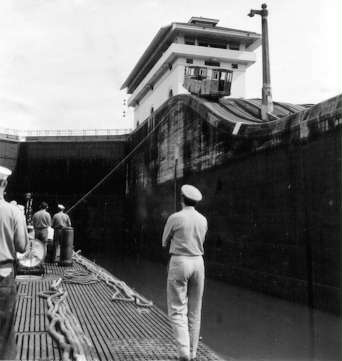
I , in a intoxicated state, bought a baby alligator in Panama and brought it aboard the Bergall. The next morning reality hit me and as I was wondering what to do when one of the officers came into the FTR and said it was cute, stuck his finger in front of it and, when we pried the alligator's jaws open, his fate was decided. He went to the great alligator heaven via #1 sanitary tank.
We went directly to New London from Panama after the powers that be decided that they had adequate submarine coverage in Korea since the North Korean Navy consisted of tugs and small patrol boats unworthy of a torpedo.
In late July of 1950 we arrived in New London, Conn. and operated with the Atlantic Fleet. We came back to the States, I think, because Captain John Hyde wanted us under his command. He had put the Bergall in commission and was our DIVCOM when we got to New London.
In the spring of 1951 we went to
Guantanamo for ASW exercises. The ASW forces used Hedgehogs (an
ahead thrown weapon which they hit us with regularity) We visited Santiago,
Cuba, Port-au-Prince, Haiti and stopped at Havana on our way home.
There aren't many officers that I hold in such high esteem as Capt. Glennon,
possibly Lt CDR Dick Clayton, XO most of the time I was
aboard. I had the deck watch in Guantanamo when CDR Glennon came up
the pier with his brand new three strips and his new cap with scrambled eggs on
it. I think the crew would have followed him into hell with a cup of
water to put out the fires..
That winter the Bergall underwent overhaul and conversion to snorkel in Philadelphia, Pa..
On April 4, 1952, We left the Navy Yard and returned to New London. After a short time the Bergall left to test out our snorkel and we snorkeled for 7 days and nights and ended up with a weekend stay at Nassau in the Bahamas.
We made a dive I'll never forget
while operating out of Guantanamo. We took 3 exercise torpedoes with
us but they had no recovery vessel so we had to recover our own. A
torpedo weighs 3000 lbs and we fired three one day. When a torpedo
is fired a tube full of water is dropped down to the poppet tank to compensate
for the weight loss. We recovered the torps but the diving officer
did not pump the 3X3000=9000 lbs out of the tank, so when we recovered the
torps. We took aboard another 9000 lbs. in torpedoes.
Now we are 9000 lbs out of trim, all of it forward. When we dove we
headed for the bottom at about a 45 degree angle which put the props out of the
water until we were deep enough to cover them. I had the helm on
that dive and had both hands on the maneuvering room annunciators watching Capt.
Glennon as he was watching the depth gauge to determine when our props went
under (can't go all back emergency with the props out of water). As
he said "all back emergency" I had it rung up and answered before he finished
saying it. We also blew all main ballast tanks.
We lived.
On each side of the torpedo tubes, against the bulkhead, there was an impulse bottle (air bottle) for each of the three tubes on that side. Directly over the impulse bottles was a sea pressure gauge and the impulse bottles were filled with compressed air to a point 50 PSI over what the sea pressure gauge read. When fired, the air was fed into the tube at a measured rate by the tube firing valve which then had to be refilled with water, the agent that determined the air flow rate to the tube. After the outer tube door was closed the tube was vented into the torpedo room before draining. These tube vent valves are lined up over the tubes and were often used to kind of hang on to, thus creating the phrase "riding the vents", a way to describe inactivity.
Salt water is often carried in the tubes to compensate for the weight lose when a torpedo is launched, therefore it was necessary when in overhaul, to climb inside the tubes with a power wire brush and remove the accumulated salt. This was not a job I enjoyed.
The normal torpedo during my time was the MK14. It was a dual speed torp being 35 knots on low speed and 45 knots on high speed. The range was reduced accordingly on high speed. The MK 17 was, as far as I can remember, nothing more than a single speed MK 14. They had the same external dimensions. They were both steam turbine and subsequently left a very visible wake due to the exhaust of the combustion gases. The mid section (the largest section) was the air flask. The afterbody had small tanks for water and alcohol which were metered, along with air, into a combustion chamber and ignited by an igniter which burned the length of the run. The steam generated turned two turbines that powered the props through reduction gears. The afterbody also contained the guidance system, which was a gyro and pawls working against the base of the gyro. The exhausted gases made a wake that all an escort had to do was follow the wake to it's source. The MK 18 was an electric torp and as such left no wake. It was much favored by the wartime crews even though it only had a speed of 35 knots.
Here we are loading a MK 17 Mod
3A torpedo onboard.
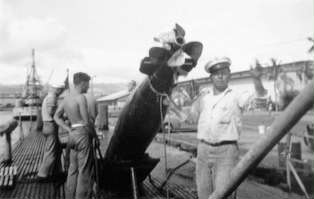
Sometimes we had to retrieve our own. This is another MK17 MOD3A.

We had Filipino Stewards mates during the period I was aboard and they slept in the traditional bunks under the forward torpedo loading hatch. The officers were treated special in that the Stewards served them dinner, coffee, made their beds etc. Our stewards mates stayed with the boat and were there when I left. Due to the long trip by prop planes, they saved up their leave and were granted permission to take 90 days at a time to go home to the Philippines. These guys would go on liberty to some unknown place that their fellow countrymen had set up. They dressed for liberty in the FTR and, after their blues were on, they would put on a shoulder holster containing a 7.65mm Beretta (.32 cal). I had one myself but didn't carry it. The boats going to the Med were in the gun running business.
Here is a shot of me on deck watch. I am not saluting, but
rather, shielding my eyes against the sun trying to see what the hell anyone
would be doing up there in the periscope shears. The discolored deck
pieces are the tops of the line lockers. The plastic dome at the
bottom of the picture is a Plexiglas windshield and half cover for the OD when
we were on the surface.
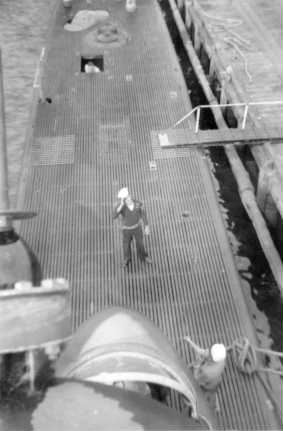
I don't think any group was capable of letting of steam as well as submariners. Even in peacetime, tension built up and needed an outlet. I quit drinking, not out of choice, but because I had my gall bladder out and alcohol made me deathly ill afterward. Everyone is either unaffected or affected in different ways when the gall bladder is removed.
In Santiago Doc Roehs was in the crews mess sanding the name off APC's. I had the below deck watch so I stopped and asked what was the reason. He had sold all the penicillin pills to the Cubans at $1.00 each and ran out, so he was making more. He would not give a penicillin pill to a crew member because he said it would only mask the primary symptoms of STD and would prevent discovery until it was too late.
I still have hangovers and I quit
drinking 15 years ago. We were the only American ship there that
weekend and the price was right for EVERYTHING!!. Here's a shot of me and F. J.
(Doc) Roehs.
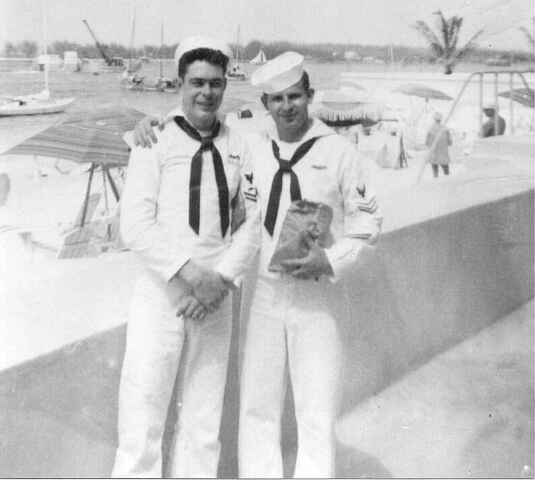
While in Haiti in 1951 I was totally disgusted with the poverty, filth and the general attitude of the country. I wouldn't have had sex there using an enemy's penis. One day we were sitting drinking beer and eating lunch when a black prostitute who was about 8 months pregnant offered me sex, anyway I wanted it, for 50 cents. I looked around and there was a group of our officers at the other end of the establishment. I gave her a dollar and told her to go over there and say to Mr. Braly " What are you going to do about our baby?". Mr. Braly's normally dark face turned beet red and I was very nonchalant as if I didn't know what was happening.
I went to sonar school in Key West, I guess over the winter of 50-51. I was a TM3 at the time but they wanted someone from the FTR who could operate the sonar console there. In the winter of 51-52, I went on 30 days leave and rejoined the boat at Philadelphia.
I even met Capt. Hyde once as he rode the boat as DIVCOM. At that time he had salt/pepper hair and was more heavy set than the pictures shown on this site.
I was on her for her 2,000th dive
and here's my momento for also being onboard for the Bergall's 3,000th dive.
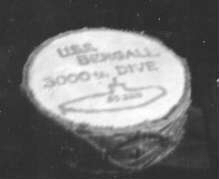
We lost two people from the boat due to their mistakes. One was an Engineman striker that could not cut it although he must have had something. He was the only person I know of that had credit at a whorehouse. (Ya pays before cause it's worth a lot more than after). The other was a cook that traded all our beef (cumshaw) for stainless steel wainscot in the crews mess, then tried it cover the lack of meat by serving fried rice for a week. Problem was the wardroom was eating out of the same pot the crew was.
My most uncomfortable place on a submarine was inside a 21" diameter torpedo tube with a power wire brush removing the salt buildup during upkeep. I thought, "If this wire brush gets lose, I'm hamburger".
To return to memories of
the SS 320, click here.
To return to the main page of the SS 320, click here.